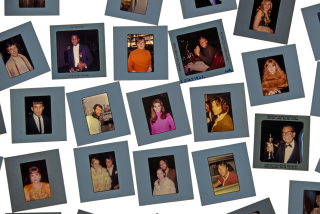A Legacy of Taste and Style Left in Miami
- Share via
I never met Gianni Versace and have neither physique nor wallet nor attitude to wear his clothes, yet my love affair with his Miami Beach villa has stretched more than 15 years.
When I heard that he had been gunned down Tuesday morning on its salt-frosted coral rock front steps, my heart mourned.
Our only connection was the building once known as the Amsterdam Palace, for my money (and his) the single most wonderful structure in the architectural fantasy land of South Beach.
I had hated him when he bought the three-story apartment building and ousted its surreal menagerie of tenants in order to make it his private domain. Later, after he restored the place with grace and wit and all the impeccable taste you might expect of an Italian designer, I loved him.
It wasn’t just that he appreciated and restored the long-neglected building, but that he had proved himself to be more than a conspicuous-consumption addict with an edifice complex. He actually lived there, and became an important thread in the colorful fabric of a neighborhood reweaving itself in wondrous ways.
The Amsterdam Palace was shown to me one twilight at the end of the ‘70s by a young reporter and connoisseur of urban funk. I had just been named Beach bureau chief for the Miami Herald, and my guide was introducing me to the dilapidated secrets of a rundown neighborhood still 10 years and one hit TV show away from the glory it was to become.
Surrounded by faded but still shapely Art Deco hotels, the Amsterdam Palace wasn’t Deco at all. It was a replica of the stately Mediterranean villa Christopher Columbus had built in the Dominican Republic between voyages, a whimsical shrine to ancient wisdom and timeless risk-taking.
You entered through a gigantic iron gate, corroded by sea air from the persistently pounding Atlantic just across Ocean Drive, and emerged in an inner courtyard, open to the sky. Before you lay a splashing fountain, riotous bougainvillea and, straight ahead, a three-story tower concealing a rickety elevator and topped by a copper-domed observatory.
On each of the three levels a walkway encircled the courtyard. The walls on each level were punctuated with plaques bearing the sculpted-plaster faces and quotations of ancient Great Men of science and philosophy. Socrates. Galileo.
Onto these walkways opened the couple dozen apartments, populated at various times by a rainbow of free spirits (including the local punk rock promoter who would periodically clank into our office, all chains and black leather in the humid 95-degree afternoon, to drop off fliers for some upcoming show).
Years later at a Joan Baez concert I found myself sitting next to a whooping, howling earth mama who, once we started making small talk, revealed that she had once lived in the Amsterdam Palace’s observatory. She treasured her salacious memories of the X-frame bed she had suspended by chains from the dome. Mercy.
On the roof, in those pre-Mariel, pre-”Miami Vice,” pre-”hot hot hot is cool cool cool” days, someone had parked a couple of broken-down wooden chairs. Perfectly positioned for enjoying a tequila sunrise, in every sense.
I’d sneak back in from time to time, as my career carried me away from the Beach and heroic efforts to revive the stagnant neighborhood began to succeed, and then to snowball.
The semi-deserted Ocean Drive out front was now gridlocked day and night. The front porches once lined with old Jews in black socks, white nose guards and aluminum chairs were now lined with chic cafes.
Versace brought energy and enthusiasm and money to a neighborhood that needed all three. He believed in the place, and his first-class restoration of the Amsterdam Palace challenged others to do the same.
More to Read
Sign up for The Wild
We’ll help you find the best places to hike, bike and run, as well as the perfect silent spots for meditation and yoga.
You may occasionally receive promotional content from the Los Angeles Times.


![Architect Harry Gesner on the deck of his 1957 Wave House in Malibu. The architect, who built singular homes inspired by organic forms, died on June 20, 2022 at the age of 97. [This image is for use only in conjunction with Harry Gesner obituary.]](https://ca-times.brightspotcdn.com/dims4/default/20f7a67/2147483647/strip/true/crop/4000x2675+0+0/resize/320x214!/quality/75/?url=https%3A%2F%2Fcalifornia-times-brightspot.s3.amazonaws.com%2Fdd%2Fe8%2F5b486c1348d5a831faf2a73089c5%2Frbc-06-family-portrait-balcony-lippman-0915-v10-rgb.jpg)



